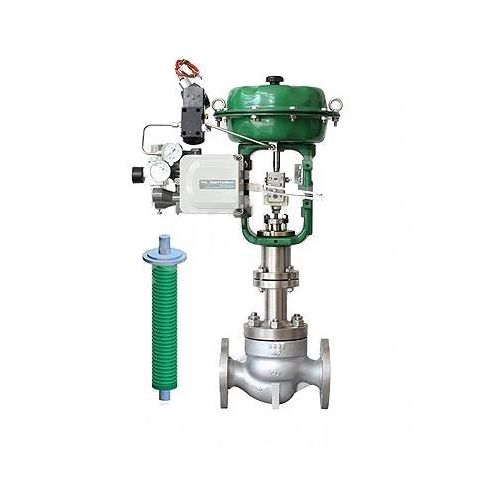Magpie Valves: Precision Selection, Perfect Control
Valve Technology Insights: Seal Selection for High-Temperature Heat Transfer Oil Valves: How Dual Protection Builds a Strong Safety Barrier
In industries such as chemicals, petrochemicals, and synthetic fibers, high-temperature heat transfer oil systems serve as the "arteries" of production lines. Operating at temperatures above 200°C, they deliver stable thermal energy to key equipment like reactors and dryers. However, this "thermal lifeline" hides significant risks, once heat transfer oil leaks due to valve seal failure, it can instantly ignite upon contact with air, leading to flash fires or even catastrophic accidents. So, how can such leakage risks be eliminated from the source? The answer lies in dual sealing systems that combine bellows and packing seals, now the standard configuration for safety in high-temperature applications.

The hazards of heat transfer oils are closely tied to their operating temperatures. Take biphenyl-ether based fluids, for example: while their autoignition point is around 300°C, they typically operate between 220°C and 280°C. If a valve seal fails, the liquid oil can vaporize rapidly, forming an explosive vapor cloud. When this cloud encounters static electricity, sparks, or hot surfaces, it may detonate.
Limitations of Packing Seals: Single-layer flexible graphite or asbestos packing degrades over time due to thermal carbonization. The repeated movement of the valve stem accelerates wear, expanding the sealing gap and exponentially increasing leakage risk over time.
Single-Point Failure of Bellows Seals: Though metal bellows effectively isolate the medium, extreme conditions, such as pipeline vibration or pressure shocks, may cause fatigue cracks. Once the bellows fail, there is no secondary defense to prevent leakage.
According to safety reports from a chemical industry park, heat transfer oil valves with single seals show leakage rates as high as 35% after 1–2 years, with related accidents accounting for 42% of all incidents in similar systems.
To mitigate the risk of leakage under high temperatures, a composite seal design combining bellows + packing introduces a dual-layer safety system, based on the principle of layered defense:
Constructed from 316L stainless steel or Hastelloy alloys, metal bellows are formed using cold-forming techniques to create a dense, wave-like structure that balances flexibility and rigidity.
High Temperature Resistance: Withstand over 400°C, eliminating the softening issues of rubber/plastic seals.
Dynamic Sealing: The bellows stretch and compress in sync with valve stem movement, keeping the heat transfer oil completely contained inside the valve and protecting the packing from direct media exposure.
Extended Service Life: Tested bellows exhibit fatigue life exceeding 100,000 cycles, far outperforming the 20,000–30,000 cycle limit of packing-only seals.
Should the bellows rupture (e.g., from impact), the secondary packing provides critical backup containment:
Upgraded Materials: High-purity flexible graphite with nickel wire reinforcement resists up to 450°C and features self-lubricating properties to reduce stem friction.
Optimized Structure: Multi-layer packing with interstage spacers distributes pressure evenly and prevents collapse failures typical of single-layer designs.
Ease of Maintenance: External packing glands allow for online adjustment—minor leaks can be corrected without shutting down the system.
Rather than simply stacking seals, this dual-seal strategy creates complementary advantages:
Improved Thermal Management: Bellows isolate the high temperature, reducing the thermal load on the packing by 30–50°C, thereby slowing material degradation. Packing replacement cycles are extended from 6 months to over 18 months.
Multi-Barrier Leak Prevention: Should the bellows fail, the escaping medium must pass through a complex, labyrinth-like packing path—reducing leakage volume by over 98% compared to single seals.
Quantified Risk Reduction: Dual-seal valves certified to SIL (Safety Integrity Level) standards can achieve a PFD (Probability of Failure on Demand) of 10⁻⁵, meeting SIL2 safety criteria.
Achieving the full safety benefits of dual-seal systems requires attention to three core areas:
Bellows: Prefer Inconel 625 or similar high-temperature alloys. Avoid 304 stainless steel in sulfur-containing fluids to prevent intergranular corrosion.
Packing: Avoid organic fiber-based packing (e.g., aramid) to prevent carbonization and particulate wear.
Valve Body: Opt for forged construction to prevent casting defects like porosity, which can lead to creep leakage.
Bellows effective area must match valve stem size to distribute stress evenly.
Increase packing chamber depth by 10–15% to accommodate multiple layers, and add heat-dissipating fins to reduce local temperatures.
Include leak detection ports for sensors that monitor temperature or combustible gases to detect early seal failure.
Maintain a dual-seal status log, tracking bellows cycles and packing torque to predict service intervals.
Perform tightness testing with nitrogen (at 1.1x operating pressure) during every startup/shutdown cycle—focus on bellows welds and packing interfaces.
Avoid throttling when valves are half-open to minimize stem vibration and fatigue damage to seals.
In a heat transfer oil system retrofit at a petrochemical refinery, replacing single-packing control valves with dual-seal valves (bellows + packing) led to:
Zero visible leakage in 18 months of operation.
Combustible gas alarm incidents dropped from 3–5 times/month to none.
Oil loss reduced from 12 tons/year to 1.5 tons, saving CNY 400,000/year in replenishment costs.
Production downtime losses decreased by approx. CNY 1.2 million/year.
This confirms a key principle: investing in seal safety is essentially an insurance policy against production risk.
Safe operation of heat transfer oil systems hinges on precise thermal control. Once fluid temperatures exceed 200°C, single-seal systems approach the limits of reliability. The combination of bellows and packing seals is more than just a material upgrade, and it embodies a layered risk-control philosophy. The primary barrier (bellows) proactively isolates the fluid, while the secondary barrier (packing) passively intercepts leaks, transforming high-temperature energy from a latent hazard into a secure, productive force.
For industries like chemicals and petrochemicals, this "dual protection" strategy is both a reflection of compliance with safety standards and a clear execution of preventive safety philosophy. After all, in industrial safety, redundancy is never waste; it's a fundamental act of respect for life, equipment, and the environment.
If you have questions about valve sealing technologies, feel free to follow Magpie Sealing and leave a comment or inquiry. Thank you!
